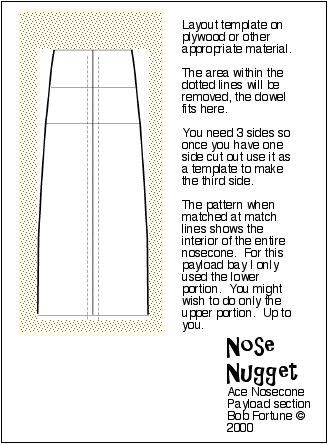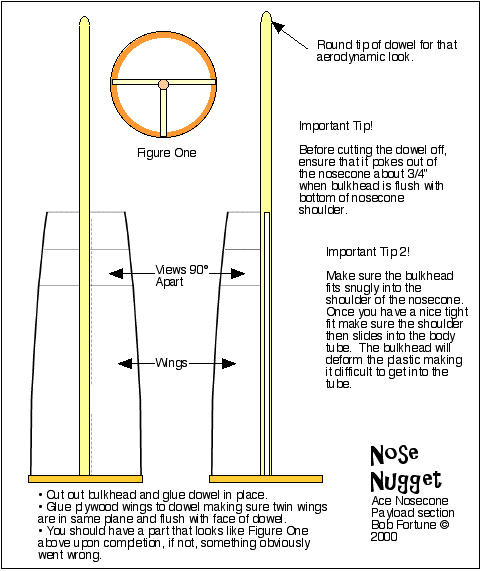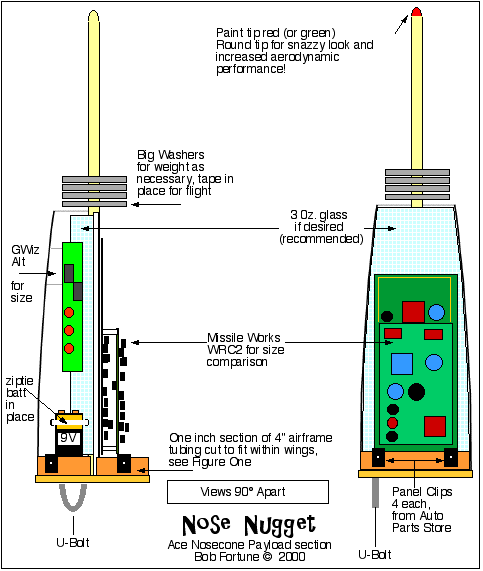| Manufacturer: | Scratch |

|
- A relatively simple way to install a payload in a 3.9" Ace Nosecone Parts List:
|
|
Assembly Instructions: Download the 2 templates and print out on your printer. There are 1" square boxes on each template to indicate correct sizing, you may have to fiddle with your printer output to get the correct size. These are .gif images. Once you have the templates sized and printed cut them out and match the two halves to the match line shown. The entire cone is drafted though you don't need them both if you don't intend to make the entire nosecone a payload section. My design only has the last 6" or so of the cone interior as payload. The lines are there so you can cut to size as you choose. Using a spray mount adhesive, glue the template to the balsaply. Cut the template to rough shape. Using a sander or rasp or whatever, sand the template to it's final shape. Don't attempt to cut the template out dead-on to the lines, it's much easier to get it close then sand to get it perfect. While you have this template cut your fiberglass cloth to fit, you need one piece this size. Once you have the balsaply cut to size, cut along the dotted line. This is where the dowel goes. These two parts I am calling "wings" for the sake of clarity. Take one wing and use it as a template to cut an additional wing. This third wing becomes a "strong back" to support the two wings and dowel in the cone. Using this wing as a template cut an additional two pieces of glass, but a bit oversize - maybe an inch wider. Set the glass aside for later use. On the second template there is a bulkhead template. Glue this to 1/4" ply and cut out. Take the Ace nosecone and trim off the bottom part (where the screw top thing is). Cut it right where the wall intersects the base. The 1/4" ply bulkhead slides in here. Test fit the bulkhead and sand as necessary to get a good fit. If the bulkhead is oversize it will balloon the shoulder of the NC and the airframe (AF) tube won't fit. Test it with a section of AF you intend to use. Drill a 3/8" hole in the center of the bulkhead. Drill two holes to receive the U-bolt. I made the dowel poke out the tip of the nosecone because it was fun to do. It's not critical, you can simply make the dowel shorter. The purpose of the tip protuding is to center the payload section in the nosecone, a job the wings if cut properly can do.While you have the nosecone in hand, whack off the tip of it so a 3/8" hole is developed. I used a bench grinder for this and it takes some grinding and fitting. The fit is important so make sure it's nice and snug, take your time. Fit the dowel into the NC so an inch or so protrudes from the tip. Add a bit of yellow glue to the dowel just at the base of the shoulder line Slide the bulkhead over the dowel and into the shoulder. The dowel is now square to the NC if you trimmed the tip properly. CA the dowel to the bulkhead and remove by pulling on the dowel protruding from the bulkhead. Clamp this is a vise or something handy to keep it from moving around. Using yellow glue, glue the three wings to the dowel. The two wings in the same plane are flush with the tangent of the dowel cross section. The third wing is at 90 degrees to these wings. Let dry. Get the 1" piece of airframe and cut it into 3 pieces. One piece will be 180 degrees and the other two 90 degrees. You will need to remove some of the tube to make it fit inside the wings, a pair of strong scissors works well. When fitting the pieces, make sure that they are not flush with the edge of the bulkhead. Hold them back off the edge (towards the dowel) as the panel clips need to clear the shoulder of the nosecone. Glue these pieces to the bulkhead and to the wings. This becomes the retainer ring. Test fit the part in the nosecone. If it doesn't fit, sand all the parts to make it fit. It needs to slide in and out nicely. Get your 3 pieces of glass cloth. Mix up some epoxy. Get a little paint brush. Brush on a coat of resin on the face of the wings. Place the glass on the face of the wings. Wet out the glass so it disappears. Turn part over and repeat on strongback with two pieces of glass. Using the brush in dabbing motions, stipple the glass onto the surface so all the glass is in contact with the balsaply. This is easiest as the resin begins to set and becomes tacky. Try to eliminate all the air bubbles. Allow to cure to B stage (this is when the epoxy is kind of rubbery) and trim the glass to the correct size. Find out where the hole in the panel clip lines up on the retainer ring. They are all different so you have to fit and see. Generally the hole with the clip in place is about 1/2" down from the U bend in the clip. Make a note where the hole hits the retainer ring. Install the U-bolt at this time. Using the shoulder of the NC as a guide, mark the base of the nosecone on your airframe. Install the payload section into the NC. Install the NC on the airframe you intend to use. Using the mark you just made and your measurement of the panel clip on the retainer ring drill 4 holes 90 degrees from each other around the airframe. If they are not dead on, the airframe will only align with the holes as drilled. Make a mark on the NC and on the airframe where the holes line up properly. Remove the nosecone. Remove the payload section. Install the panel clips. Reinstall the nosecone. Reinstall the payload section. Install 4 #8 screws, The nosecone ain't coming off for nothin'. All the parts are working together to keep the electronics you install on the board in place and in the nosecone. The U-bolt will take a major hit and will transfer the load to the airframe through the panel screws and retainer ring. You may have problems if you use some serious noseweight so take care. Deployment shock loads can be upwards of 15 or 20 g's making a one pound noseweight suddenly equal to a 20 pound noseweight. Install some electronics, a power source, a shunt for your pyro, and go flying! |
|
Flight Report This nosecone flew with on a Binder Raptor on a J350. Unfortunately the motor ejection charge went early due to an improper seal in the forward closure delay well. (Pilot error) It was supposed to be a long delay to back up the electronics but it was way short. : ) The charge went off while the rocket was still boosting but the thing held together, the chute deployed, and no damage was done. Bob Fortune |



|
1_On_2manyfins.jpg 16K |
 2_BH_view.jpg 16K |
3_Push_the_button_NF.jpg 18K |
 4_Face_view.jpg 23K |
|
5_Strongback_view.jpg 10K |
 6_looking_down_NF.jpg 7K |
 7_Side_x_side_NF.jpg 11K |
Sponsored Ads
 |
 |














